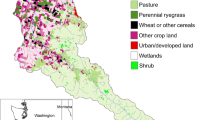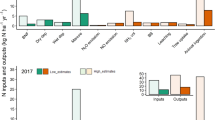Abstract
Although agricultural systems in tropical monsoon Asia play a central role in the global nitrogen (N) cycle, details of the N cycle in this region on a watershed scale remain unclear. This study quantified the N budget in a tropical watershed of 221 km2 on Java Island, where paddy fields cover 28% of the land, by conducting field surveys. The amount of net biochemical gaseous N loss to the atmosphere (X GB ), which is generally difficult to determine, was calculated as the residual of the N balance. Assuming that NH3 volatilization balances deposition, and hence subtracting NH4–N from the N import with atmospheric deposition, the average total import and export of N per year was found to be 46.5 kg ha−1 year−1 over the watershed. Of this, 71% was imported as fertilizer (M F ) and 29% with atmospheric deposition (M AD ). On the export side, 42% was lost as X GB , 37% with incineration of rice residues and wood fuel (X GI ), 13% with river discharge (X D ) and 9% with rice surplus export (X R ). A large portion of X GB , and consequently, a small portion of X D could be explained by the high rate of denitrification resulting from the high temperature and humid climate, and are thought to be common features of tropical watersheds where paddy fields are found.







Similar content being viewed by others
References
Bechmann M, Eggestad HO, Vagstad N (1998) Nitrogen balances and leaching in four agricultural catchments in southeastern Norway. Environ Pollut 102:493–499
Beaujouan V, Durand P, Ruiz L (2001) Modelling the effect of the spatial distribution of agricultural practices on nitrogen fluxes in rural catchments. Ecol Model 137:93–105
Buresh RJ, De Datta SK (1990) Denitrification losses from puddle rice soils in the tropics. Biol Fertil Soils 9:1–13
Bouwman AF, Boumans LJM (2002) Estimation of global NH3 volatilization loss from synthetic fertilizers and animal manure applied to arable lands and grasslands. Global Biogeochem Cycles 16(2):GB1080. doi:10.1029/2000GB001389
Boyer EW, Goodale CL, Jaworski NA, Howarth RW (2002) Anthropogenic nitrogen sources and relationships to riverine nitrogen export in the northeastern U.S.A. Biogeochemistry 57/58:137–169
Campbell GS, Norman JM (1998) An introduction to environmental biophysics, 2nd edn. Springer-Verlag, New York
Cannell MGR (1982) World forest biomass and primary production data. Academic press, London
Clay DE, Malzer GL, Anderson JL (1990) Ammonia volatilization from urea as influenced by soil temperature, soil water content and nitrification and hydrolysis inhibitors. Soil Sci Soc Am J 54(1):263–266
Downing JA, McClain M, Twilley R, Melack JM, Elser J, Rabalais NN, Lewis WM Jr, Turner RE, Corredor J, Soto D, Yanez-Arancibia A, Kopaska JA, Howarth RW (1999) The impact of accelerating land-use change on the N-cycle of tropical aquatic ecosystems: current conditions and projected changes. Biogeochemistry 46:109–148
FAOSTAT (2005) FAO statistical databases, accessible through the food and agriculture organization of the United Nations, http://faostat.fao.org/
FAO/WHO (1973) Energy and protein requirements: report of a joint FAO/WHO ad hoc expert committee. WHO Technical Report 522, Geneva. Switzerland
Fillery IRP, De Datta SK (1986) Ammonia volatilization from Nitrogen source applied to rice fields: I. Methodology, ammonia flux, and nitrogen-15 loss. Soil Sci Soc Am J 50:80–86
Freifelder RR, Smith SV, Bennett RH (1998) Cows, humans and hydrology in the nitrogen dynamics of a grazed rural watershed. J Environ Manage 52:92–111
Galloway JN, Schlesinger WH, Levy II H, Michaels A, Schnoor JL (1995) Nitrogen fixation: anthropogenic enhancement-environmental response. Global Biogeochem Cycles 9:235–252
Gillett RW, Ayers GP, Selleck PW, Mhw T, Harjanto H (2000) Concentrations of nitrogen and sulfur species in gas and rainwater from six sites in Indonesia. Water Air Soil Pollut 120:205–215
Gundersen P, Bashkin V (1994) Nitrogen cycling. In: Moldan B, Cerny J (eds) Biogeochemistry of small catchments: a tool for environmental research SCOPE report. Wiley and Sons, Chichester, pp 255–283
Hargrove WL, Bock BR, Raunikar RA, Urban WJ (1987) Comparison of a forced-draft technique to nitrogen-15 recovery for measuring ammonia volatilization under field conditions. Soil Sci Soc Am J 51:124–128
Hossain M (2005) Global rice economy: long-term perspectives. In: FAO (ed) Proceedings of the FAO rice conference, rice in global markets. FAO, Rome, pp 1–7
Houston JA, Brooker MP (1981) A comparison of nutrient sources and behaviour in two lowland subcatchmens. Water Res 15(1):49–57
Howarth RW, Billen G, Swaney D, Townsend A, Jaworski N, Lajtha K, Downing JA, Elmgren R, Caraco N, Jordan T, Berendse F, Freney J, Kudeyarov V, Murdoch P, Zhao-Liang Z (1996) Regional nitrogen budgets and riverine N, P fluxes for the drainage to the North Atlantic Ocean: natural and human influences. Biogeochemistry 35:75–139
Jordan TE, Weller DE (1996) Human contributions to terrestrial nitrogen flux. Bioscience 46:655–664
Juliano BO, Bechtel DB (1985) The rice grain and its gross composition. In: Juliano BO (ed) Rice chemistry and technology. American association of cereal chemists. 2nd edn. St. Paul, Minnesota, pp 17–57
Kato T, Soumura H, Goto A (2002) Water quality forecast model of Cidanau Watershed, Indonesia, for water management planning. Rural Environ Eng 43:3–12
Kronvang B, Hoffmann CC, Svesden LM, Windolf J, Jensen JP, Dorge J (1999) Retention of nutrients in river basins. Aquatic Ecol 33:29–40
Ludwig J, Marufu LT, Huber B, Andreae MO, Helas G. (2003) Domestic combustion of biomass fuels in developing countries: a major source of atmospheric pollutants. J Atmos Chem 44(1):23–37
Makarim AK (2000) Bridging the rice yield gap in Indonesia In: Papademetriou MK, Dent FJ, Herath EM (eds) Bridging the rice yield gap in the Asia-Pacific region. FAO Publication, Bangkok, pp 112–121
Matthews E (1994) Nitrogenous fertilizers: global distribution of consumption and associated emissions of nitrous oxide and ammonia. Global Biogeochem Cycles 8:411–439
Mcisaak GF, Hu X (2004) Net N input and riverine N export from Illinois agricultural watersheds with and without extensive tile drainage. Biogeochemistry 70:251–271
Payraudeau S, Tournoud MG, Cernesson F, Picot B (2001) Annual nutrients export modelling by analysis of landuse and topographic information: case of a small Mediterranean catchment. Water Sci Technol 44(2–3):321–327
Quynh LTP, Billen G, Garnier J, Thery S, Fezard C (2005) Nutrient (N, P) budgets for the Red River basin (Vietnam and China). Global Biogeochem Cycles 19:GB2022. doi:10.1029/2004GB002405
Roberts G (1987) Nitrogen inputs and outputs in a small agricultural catchement in the eastern part of the United Kingdom. Soil Use Manage 3(4):148–154
Schleisinger WH, Hartley AE (1992) A global budget for atmospheric NH3. Biogeochemistry 15:191–121
Smith RV (1977) Domestic and agricultural contributions to the inputs of phosphorus and nitrogen to Lough Neagh. Water Res 11:453–459
Swift MJ, Anderson JM (1989) Decomposition. In: Lieth H, Werger MJA (eds) Tropical rain forest ecosystems, biogeographical and ecological studies, ecosystems of the world 14B. Elsevier science publishers, Amsterdam, pp 547–569
Soesastro MH (1984) Policy analysis of rural household energy needs in West Java. In: Islam MN, Morse R, Soesastro MH (eds) Rural energy to meet development needs: Asian village approaches. Westview Press Inc., Boulder, pp 89–134
Tsuyuki S, Baba A (2003) Detecting land use change using remote sensing in Cidanau watershed, Indonesia. In: Hayashi Y, Manuwoto S, Hartono S (eds) Sustainable agriculture in rural Indonesia. Gadjah Mada University Press, Yogyakarta
Tareq SM, Tanaka N, Ohta K (2004) Biomaker signature in tropical wetland: lignin phenol vegetation index (LPVI) and its implications for reconstruction the paleoenvironment. Sci Total Environ 324:91–103
Tareq SM, Tanoue E, Tsuji H, Tanaka N, Ohta K (2005) Hydrocarbon and elemental carbon signatures in a tropical wetland: biogeochemical evidence of forest fire and vegetation changes. Chemosphere 59:1655–1665
Vitousek PM, Sanford RL (1986), Nutrient cycling in moist tropical forest. Ann Rev Ecol Syst 17:137–167
Vitousek PM, Aber JD, Howarth RW, Likens GE, Matson PA, Schindler DW, Schlesinger WH, Tilman DG (1997) Human alteration of the global nitrogen cycle: sources and consequences. Ecol Appl 7(3):737–750
van Breemen N, Boyer EW, Goodale CL, Jaworski NA, Paustian K, Seitzinger SP, Lajtha K, Mayer B, Van Dam D, Howarth RW, Nadelhoffer KJ, Eve M, Billen G (2002) Where did all the nitrogen go? Fate of nitrogen inputs to large watersheds in the northeastern U.S.A. Biogeochemistry 57/58:267–293
Vuorenmaa J, Rekolainen S, Lepisto A, Kenttamies K, Kauppila P (2002) Losses of nitrogen and phosphorus from agricultural and forest areas in Finland during the 1989s and 1990s. Environ Monit Assess 76:213–248
Ying J, Peng G, Zhou N, Visperas RM, Cassman KG (1998) Comparison of high-yield rice in tropical and subtropical environments II. Nitrogen accumulation and utilization efficiency. Field Crops Res 57:85–93
Yoshikawa N, Shiozawa S (2006) Estimating variable acreage of cultivated paddy fields from preceding precipitation in a tropical watershed utilizing Landsat TM/ETM. Agric Water Manage 85(3):296–304
Acknowledgements
This work was part of the Cooperative Project between the University of Tokyo and Bogor Agricultural University (IPB), the Core University Program of “Harmonization between development and environmental conservation in biological production”, and was financially supported by the Japanese Society for the Promotion of Science (JSPS). We are grateful to Prof. Budi I. Setiawan, IPB, for his support in our field survey.
Author information
Authors and Affiliations
Corresponding author
Rights and permissions
About this article
Cite this article
Yoshikawa, N., Shiozawa, S. & Ardiansyah Nitrogen budget and gaseous nitrogen loss in a tropical agricultural watershed. Biogeochemistry 87, 1–15 (2008). https://doi.org/10.1007/s10533-007-9164-5
Received:
Accepted:
Published:
Issue Date:
DOI: https://doi.org/10.1007/s10533-007-9164-5




